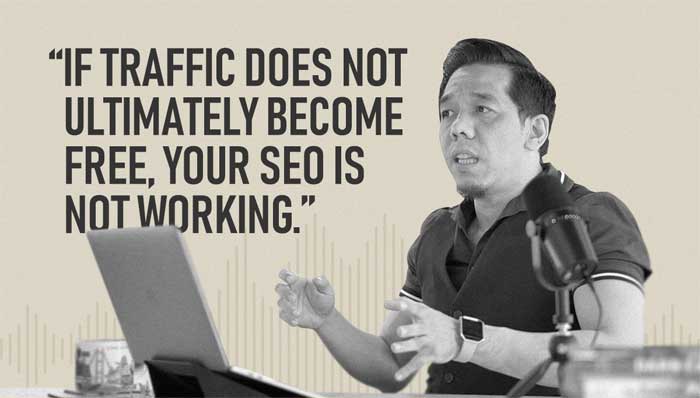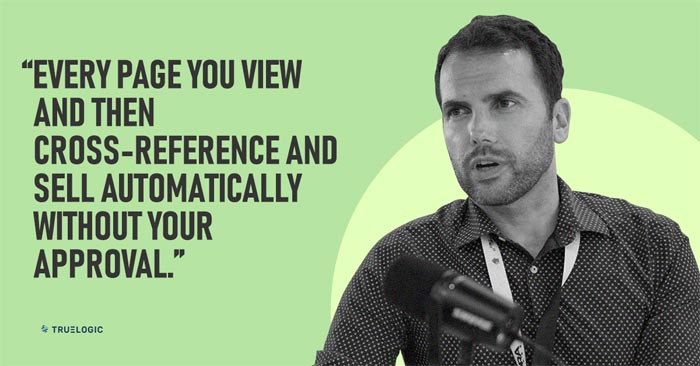Truelogic Episode 62 Recap: How to Run a Content Audit in 2023

Have your performance metrics on conversion landing pages plateaued? Organic results in search generating the same ol’ click-through rate? Well, it’s time to shake things up. Conducting a well-organized content audit to enhance specific metrics sheds light on where your existing content is falling flat and how it can be improved.
In this podcast episode, we’ll talk about how you can perform a content audit for your own business, and discover high-quality tools to help you streamline the process.
Podcast Transcription
Berns San Juan: Hi, this is Bernard, and welcome to another episode of the Truelogic DX Podcast. Today we’re talking about 2023-worthy content. So to go through the discussion, we’re going to talk about what is a content audit in a nutshell, and why your website needs it. How often should you be conducting one? What are the tools you need and then the actual steps to doing so? There’s a lot to pack in in the next 20 minutes. So let’s get started.
What is a Content Audit?
Well, in essence, when you created your website, you intended for certain pages to do certain things. If you didn’t, well, you shouldn’t. You should have done it, shouldn’t you? But you create pages and those pages are supposed to have a goal. It’s sort of like design, right? Like when you build out a page design, you do it because there’s a certain problem or there’s a certain motivation that you want to solve.
A content audit is sort of trying to figure out if that page doing that. All pages published will perform to an extent. Even non-performance, by the way, is a performance indicator. It didn’t perform. That’s a performance indicator. A content audit in the broadest sense then will tell you which of your pages perform the best and then how to do that better. And are you capturing the ideas you intended with the pages you intended to capture them with? Are you winning the ideas you wanted to win for with the pages you wanted to win them with? I’ll explain that later.
SEO agencies have a process called keyword-to-URL matching. For content, think of it as an idea for page matching. Now, according to statistics, about a third of all marketers publish content but never review the content that they had published. They never review it. They never revisit it, which is tragic, you know, until the next website releases it, which happens in like 3 to 5 years. And if you want to take a look, if you want to do that, research yourself, think it was done by a company called Curata in Boston.
Why Does Your Website Need a Content Audit?
- You want to find out which are your best-performing pages, which pages are contributing visitor leads, and traffic conversions to your business.
- It allows you to build a strategy that helps your non-performing pages.
- It allows you to create synergy between your pages. You know, I hate the word synergy because it’s such a buzzword, but essentially what that means in terms is it allows you to link complementary pages together.
- It also helps you figure out which idea you intended to capture but you missed.
- Content audits can help you answer important questions like Is this content valuable to users? Did my content meet the most basic SEO guidelines? How do people find my pages? How do people use my pages? And is the content dated or is the content still accurate? So those are the reasons why you perform a website audit.
Essentially, you know, if you care about your audience, you ought to be creating a content audit now and then.
How Often Should You Be Auditing Your Website’s Content?
Well, the type of content audit you do determines how frequently you do it. But for me, I would say at a minimum you ought to be reviewing your content annually. And there are certain pages that I think ought to be evaluated a bit more frequently especially if they are critical pages to you, awareness pages, or brand pages. That’s practice.
Review them every six months, your consideration content, your highly emotional content. So quarterly semi-annually. For your conversion content, you have to review this quarterly at least because you might also be using these pages to target your ads. And if they’re not effective, you want to act on them quickly. So, you know, audit them quarterly at the minimum if not monthly, and then, you know, review your retention content annually. These are just the contents of your blog, these are your loyalty pages, and so on.
Now for content audit tools, I use a bunch of stuff. So not only enumerate them here, of course, you use Google Search Console like that’s the first thing you need. The second thing you need is Google Analytics. The third thing you need is a screaming frog-like angry Kermit Screaming Frog. The fourth tool you need is Semrush. The fifth tool you need is Ahrefs. These are the tools that you need to be able to perform an excellent audit. And again, remember, an audit provides you with a technical action and the content action right now, because I don’t like to work manually, there is a sixth tool that I like to use. It’s called super metrics. So there is a custom program.
The Google sheet I use pulls metrics from search console analytics and screaming Frog all into one sheet, and then I can use that to sort it. But the tool that pulls the data from all of those sources is a tool called super metrics. If you’ve got the budget, if you guys can afford it, I recommend you guys try it out. If not, if you’ve got an intern, if you’ve got that entry person, then they can do this too, right? I just would not do them in the volume of hundreds of pages. If you don’t have super metrics. But super metrics is a game changer in terms of collecting all of these tools together and putting them in one single sheet.

Steps to Conducting a Content Audit
Now for the meat of this conversation, let’s talk about conducting an actual audit of a website. So and I’ll take them in steps.
1. Collect the data you need
So like I mentioned earlier, I use five tools to search console analytics, a Semrush screaming frog, and combine them all into one sheet. Step one is before you come up with any action, you have to collect the data that you need. You don’t know what needs help. You need to find out what’s performing. If you don’t know the data right, it can’t be. I feel this page needs more help. Oh, you know what? We haven’t looked at this page for the last two years, so that cannot be the allocation of your priority. So step one, before any action, collect the data on your pages.
2. Sort your data
Now, this is one of those situations where I wish I could tell you there was only one way to skin this cat, but there isn’t, right? Sorting is about prioritization, but I will tell you that for us, prioritization is usually three things. So when we sort the data up because remember, you collected the information from five different tools.
And now you want to be able to sort the URLs or the pages to find out which one gets which action. But which page appears on the top is not alphabetical, it’s not based on the folder, and so on. Normally, the way you sort it from top to bottom depends on three things because top to bottom means this is the first thing I’ll work on. The second thing I’ll work on, the third thing I’ll work on.
So normally for us, prioritization is three things we prioritize based on business objectives. The client or the business is telling us my most important products are products A, B, and C. So that is prioritization by business objectives. You might be dealing with the brand team and their customers are the different business units. You might be dealing with the CMO and they’re his customers are the different general managers of the different divisions and so on. But business objectives, right? Like in a bank, it might be savings that have the greatest voice, followed by loans, followed by cards, followed by investments, followed by so on and so forth. So that’s sorting at my business objectives.
The second way you start is by opportunity. So opportunity means you’ve got this page. So like, let’s say for the sake of simplicity, it’s a rewards card. Your rewards card has zero optimization characteristics and is already driving you 15, 20, and 30,000 visitors monthly. Imagine how many visitors it would drive you if you optimized it. So these are called opportunity pages. These are the top 100 pages of yours that are already somewhat performing but could perform significantly better. And so these are what we call sorting them by opportunity.
3. Sort them by competition
You can prioritize by competition and by competition, this is, by the way, the hardest one to do, because you have to audit your competitors. And by competition, what I mean is if I’ve got products like, let’s say, men’s bracelets, men’s accessories, leather wallets, black wallets, and so on. Let’s say have those keywords. And then whenever I type those keywords, the results that I see on Google’s first page are non-optimized. They don’t have product schema, they don’t have a prescribed meta title, they don’t have an open graph and so on, meaning they’re not optimized, right? Google is just presenting you the content that it could find on the page, but an SEO did not touch that page. So this is prioritization by competition.
So when you prioritize, you prioritize by three things. You will prioritize by either your business objectives or your client’s business objective, the opportunities you have. Meaning you’re already performing pages that could perform significantly better or by competition. The pages that are driving traffic to your competitor, the traffic that you can steal from your competitor because they’re attracting that traffic within optimized pages. So this is what I mean by so. Now, one of the most important things to do with sorting is to limit this activity to the top hundred. It doesn’t matter if you’ve got 60 pages on your website or 60,000 pages on your website, limit this exercise to 100 URLs.
Only the top 100 business pages, the top 100 opportunity pages, and the top 100 competitor pages. But focus on the top hundred only. Never more than that. Even if you’ve got 6 million pages, begin your journey at best with your top 100 pages. When you’re done with that, proceed to your next 100. But try not to get dragged into the temptation of needing a 100% audited website.
Now, once you’ve pulled your data now, let’s operate under the assumption you guys know how to use the sheet I’m talking about, and I’ll try to see if we can’t offer you guys a link on YouTube. On Facebook, we can create a copy of this sheet that I’m talking about and paste the template so that you guys can download it and try it for yourself.
But once you’ve collected that data, normally you will see the URLs on the left, and you will see the impressions that are driven by that page. You will see the number of keywords that that page performs for the number of clicks the page gets and the number of visits the page gets. Now take note, a click and a visit are not the same. A click is taken from the search console. That means a user saw you on Google search and then click and became a visitor. But visits can be paid, can be direct, can be organic.
So all clicks are visits, but not all visits are clicks. So you’ll see the data on your clicks. You’ll see the data on the number of visitors that page has. You’ll see the amount of engagement that page drives. Is it a 50% engaging page, or a 75% engaging page? 75% should be pretty ideal. There are exceptional pages that do better than 75%, but think 75% is already really good. But how much does that page engage your users?
The engagement rate is particularly important because it speaks to whether that page is satisfying the search motivation of that user being there.

4. Is that page achieving a goal?
The next thing that you audit is the goals like taking for example Truelogic’s blogs in the Truelogic DX pages inside our resource pages. The goal of that page is to engage a user. Like to get a user to linger and read the content and then maybe read another piece of content. But the goal of that page is essentially to drive them from that page to a commercial page.
Like that’s the goal of that page, and that’s the whole reason that page exists. The goal of our commercial pages, our service pages is to get somebody to send an inquiry to our sales team, right? So that’s the goal. Is that page achieving a goal? Now, if you’ve got pages with goal triggers, goal events, with stuff that can be measured but is not appearing inside your analytics, then you have to audit your setup. But it’s pretty impossible for a page with an action item for a page that drives traffic with an actionable button to have zero achievements. Like even with the numbers game alone, it should at least get like one, two, three, 12 a year. It’s impossible that that thing becomes zero.
The other metric that you want to take a look at is referrals because sometimes a page’s goal is to refer a visitor to another page and nothing else, right? Sometimes a page, like, for example, again, the Truelogic DX resource pages on the website, the goal is not to turn you into a customer. Their goal is to turn you into a lead. The goal is to drive you to a commercial page where you can send us an inquiry. And so that is a referral.
5. Know your metrics
Step for your SEO, audit the pages for the presence of the meta title, the meta description, the open graph, the H1, the keyword utilization, the alt text, the originality, and the quality of the content. A link to a relevant page a relevant related page, the goal, and the conversion tracking. So those are all of the things that you want to take a look at. So I’ll repeat that.
Do you utilize the keyword in the meta title in the open graph in the H1, Do you use the keywords like in the first 100 words in the other subheaders? Do you use it in the alt text? Is it used in the content? Do you interlink that to another resource page? And then are you tracking goals for that page? So that’s step four. You set those as a list. Now take note. While content will create a meta title, the meta description, and the H1 like that’s a content action, it is technically a technical action, right? But you just want to know which of these pages of yours are optimized in which of these pages are yours or not optimized. That leads us to the last activity.
6. Optimize the page
What are the content actions you can take after performing an audit? Well, the first thing you can do is optimize the page. So when, say, optimize the page as a content action, I mean writing a compelling meta title. And a compelling description that encourages a user to click on the website. So that’s one, that’s optimization. Utilizing the keyword in the breadcrumb, like the navigational trail that the user uses to backtrack and for them to find out how they navigated your website to land at that page, that’s optimization. Utilizing the keyword in the H1, that is optimization. Inserting the keyword in your first hundred words is optimization. Putting an alt text on or an alt tag on the images used in that page, is optimization.
Auditing the content quality, reviewing whether your content is dated or is still accurate, is optimization. Putting an inner link to a related page or acquiring an inner link even from another page that can lead to this page, is optimization. So one of the content actions you can do is to optimize.
The second content. The action you can do is to rewrite or refresh your content. So rewrite or refresh your content. If you realize that you’ve got page X and a page used to drive you for a thousand visitors and today it’s only driving you to 100, it’s probably because somebody has written something fresher, more relevant, more recent than the content that you have on that page. And so what you want to do is rewrite that page, but this time rewrite or refresh that page with an optimized meta title description, open graph, H1 keywords, alt text, interlink, and so on. But rewriting the page so that you can refresh its content. Like take for example, you might have been talking about, let’s say, best practices for avoiding online scams.
And then one of the things that you might still have there is if you get an invite from a stranger on Friendster like your content might still have that haven’t helped us friends here is like, you know, I don’t know, eight feet underground by now. So get over it. Rewrite and refresh your content.
Another content action that you might do is to consolidate your content. Consolidating your content might be, for example. Oh, you know, this is a great example because see this happen a lot. You want to be authoritative for the idea of an auto loan calculator, right? Your problem is you’ve got 12 different pages all vying for relevance for the keyword auto loan.
Worse yet, you’ve got another domain, another website that tries to perform for the keyword auto loan, like you’ve got another website that talks about. And so what they’re doing is what all of these pages are doing is they’re cannibalizing each other’s traffic where all of them together could drive you, where one page might be able to drive you, let’s say 4,000 visitors a month. Now you’ve got 4 or 5, seven, eight pages that are driving you 1,500 visitors per month. And so once you’ve got this, this is an example of where your content action is to consolidate them, put them all in one place, capture all informational keywords in one place, and consolidate your content.
The other action you can do is to redirect. What does that mean? Let’s operate under the assumption you had consolidated your content. You put all of these, let’s say, auto loan pages together in one glorious page. What do you do with the other pages? Don’t just retire them. Redirect them so that visitors that are used to using them as resources get put on your new resource page, right? So you do not consolidate without redirecting. The last action in the event, let’s say your page is pretty optimized.
The last action would be to interlink. The best way to signal to Google that these pages are related that they talk to each other and whatnot is because they link to each other. If you’re not vouching for your page, why would Google vouch for your page? So whenever you have an excuse to link back to another page, you’ve got to a commercial page, and you’ve got to do so. So those are your five content actions. Optimize, rewrite or refresh, consolidate, redirect, and link.
And that’s it for this episode. Thank you very much for listening to me for, you know, the last 20 minutes. If you’ve got questions, comments, or suggestions, give us a shout-out on social media. Subscribe to our Spotify, Google, and Apple accounts.
We’re on Facebook, LinkedIn, and YouTube, and check out our website for other resources that you might have missed in the past.
Don’t forget to subscribe to the Truelogic DX Podcast and set up your alert for our new episodes. Truelogic DX is powered by our friends at Podmachine. Thank you very much and I will see you guys all on the next episode. Cheers.










